The point geom is used to create scatterplots. The scatterplot is most
useful for displaying the relationship between two continuous variables.
It can be used to compare one continuous and one categorical variable, or
two categorical variables, but a variation like geom_jitter(),
geom_count(), or geom_bin_2d() is usually more
appropriate. A bubblechart is a scatterplot with a third variable
mapped to the size of points.
Usage
geom_point(
mapping = NULL,
data = NULL,
stat = "identity",
position = "identity",
...,
na.rm = FALSE,
show.legend = NA,
inherit.aes = TRUE
)Arguments
- mapping
Set of aesthetic mappings created by
aes(). If specified andinherit.aes = TRUE(the default), it is combined with the default mapping at the top level of the plot. You must supplymappingif there is no plot mapping.- data
The data to be displayed in this layer. There are three options:
If
NULL, the default, the data is inherited from the plot data as specified in the call toggplot().A
data.frame, or other object, will override the plot data. All objects will be fortified to produce a data frame. Seefortify()for which variables will be created.A
functionwill be called with a single argument, the plot data. The return value must be adata.frame, and will be used as the layer data. Afunctioncan be created from aformula(e.g.~ head(.x, 10)).- stat
The statistical transformation to use on the data for this layer. When using a
geom_*()function to construct a layer, thestatargument can be used to override the default coupling between geoms and stats. Thestatargument accepts the following:A
Statggproto subclass, for exampleStatCount.A string naming the stat. To give the stat as a string, strip the function name of the
stat_prefix. For example, to usestat_count(), give the stat as"count".For more information and other ways to specify the stat, see the layer stat documentation.
- position
A position adjustment to use on the data for this layer. This can be used in various ways, including to prevent overplotting and improving the display. The
positionargument accepts the following:The result of calling a position function, such as
position_jitter(). This method allows for passing extra arguments to the position.A string naming the position adjustment. To give the position as a string, strip the function name of the
position_prefix. For example, to useposition_jitter(), give the position as"jitter".For more information and other ways to specify the position, see the layer position documentation.
- ...
Other arguments passed on to
layer()'sparamsargument. These arguments broadly fall into one of 4 categories below. Notably, further arguments to thepositionargument, or aesthetics that are required can not be passed through.... Unknown arguments that are not part of the 4 categories below are ignored.Static aesthetics that are not mapped to a scale, but are at a fixed value and apply to the layer as a whole. For example,
colour = "red"orlinewidth = 3. The geom's documentation has an Aesthetics section that lists the available options. The 'required' aesthetics cannot be passed on to theparams. Please note that while passing unmapped aesthetics as vectors is technically possible, the order and required length is not guaranteed to be parallel to the input data.When constructing a layer using a
stat_*()function, the...argument can be used to pass on parameters to thegeompart of the layer. An example of this isstat_density(geom = "area", outline.type = "both"). The geom's documentation lists which parameters it can accept.Inversely, when constructing a layer using a
geom_*()function, the...argument can be used to pass on parameters to thestatpart of the layer. An example of this isgeom_area(stat = "density", adjust = 0.5). The stat's documentation lists which parameters it can accept.The
key_glyphargument oflayer()may also be passed on through.... This can be one of the functions described as key glyphs, to change the display of the layer in the legend.
- na.rm
If
FALSE, the default, missing values are removed with a warning. IfTRUE, missing values are silently removed.- show.legend
logical. Should this layer be included in the legends?
NA, the default, includes if any aesthetics are mapped.FALSEnever includes, andTRUEalways includes. It can also be a named logical vector to finely select the aesthetics to display. To include legend keys for all levels, even when no data exists, useTRUE. IfNA, all levels are shown in legend, but unobserved levels are omitted.- inherit.aes
If
FALSE, overrides the default aesthetics, rather than combining with them. This is most useful for helper functions that define both data and aesthetics and shouldn't inherit behaviour from the default plot specification, e.g.annotation_borders().
Overplotting
The biggest potential problem with a scatterplot is overplotting: whenever
you have more than a few points, points may be plotted on top of one
another. This can severely distort the visual appearance of the plot.
There is no one solution to this problem, but there are some techniques
that can help. You can add additional information with
geom_smooth(), geom_quantile() or
geom_density_2d(). If you have few unique x values,
geom_boxplot() may also be useful.
Alternatively, you can
summarise the number of points at each location and display that in some
way, using geom_count(), geom_hex(), or
geom_density2d().
Another technique is to make the points transparent (e.g.
geom_point(alpha = 0.05)) or very small (e.g.
geom_point(shape = ".")).
Aesthetics
geom_point() understands the following aesthetics. Required aesthetics are displayed in bold and defaults are displayed for optional aesthetics:
| • | x | |
| • | y | |
| • | alpha | → NA |
| • | colour | → via theme() |
| • | fill | → via theme() |
| • | group | → inferred |
| • | shape | → via theme() |
| • | size | → via theme() |
| • | stroke | → via theme() |
The fill aesthetic only applies to shapes 21-25.
Learn more about setting these aesthetics in vignette("ggplot2-specs").
Examples
p <- ggplot(mtcars, aes(wt, mpg))
p + geom_point()
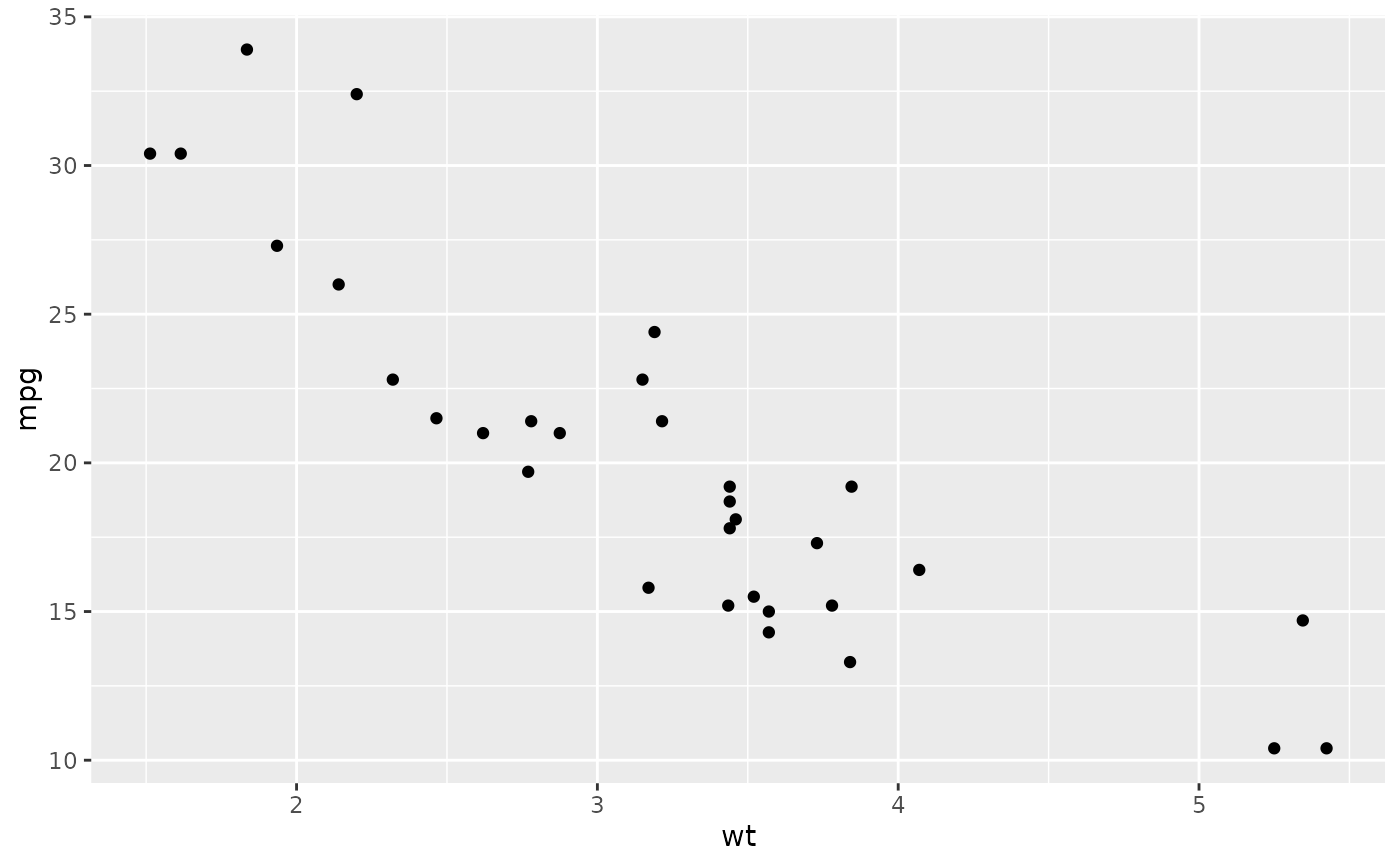 # Add aesthetic mappings
p + geom_point(aes(colour = factor(cyl)))
# Add aesthetic mappings
p + geom_point(aes(colour = factor(cyl)))
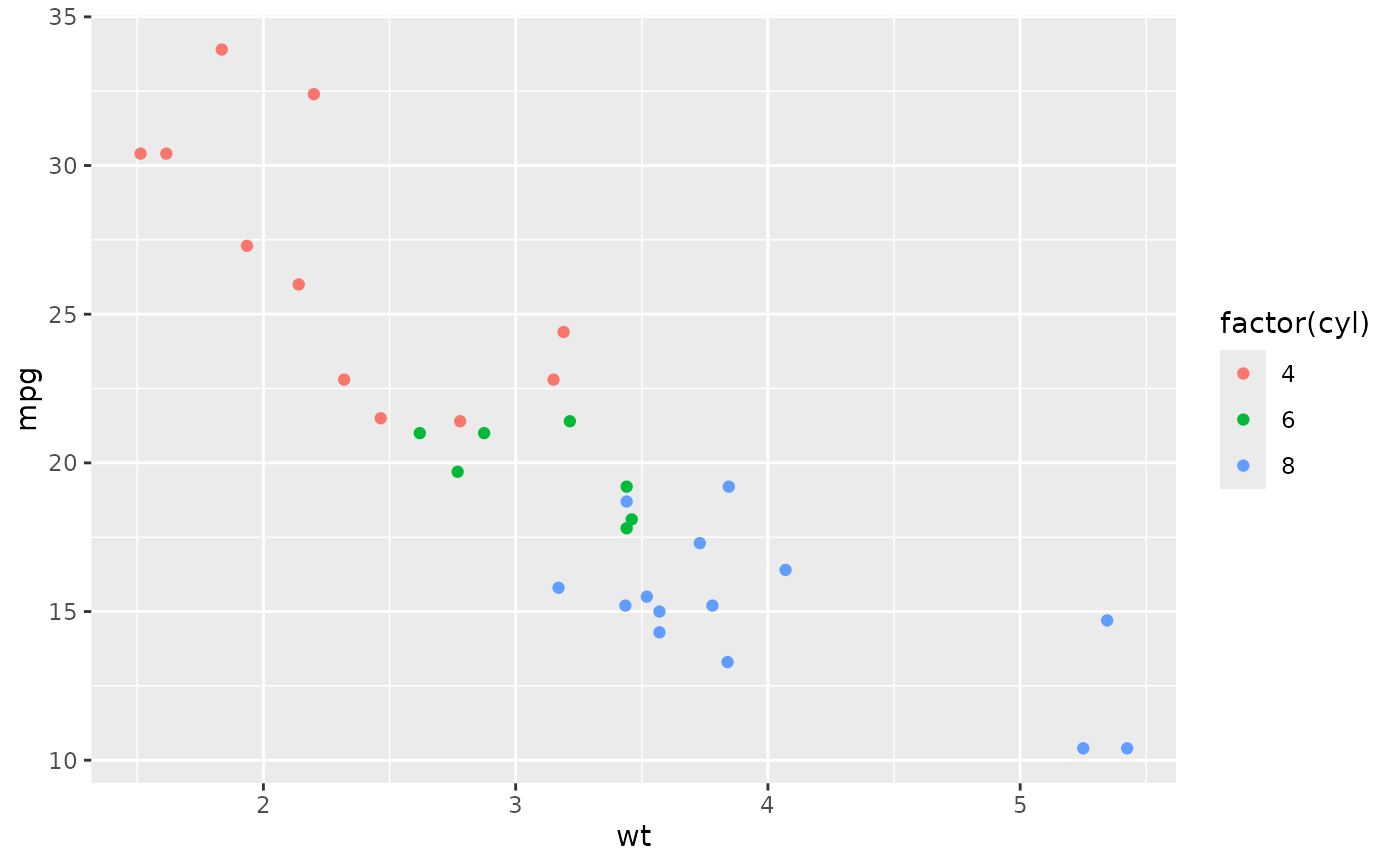 p + geom_point(aes(shape = factor(cyl)))
p + geom_point(aes(shape = factor(cyl)))
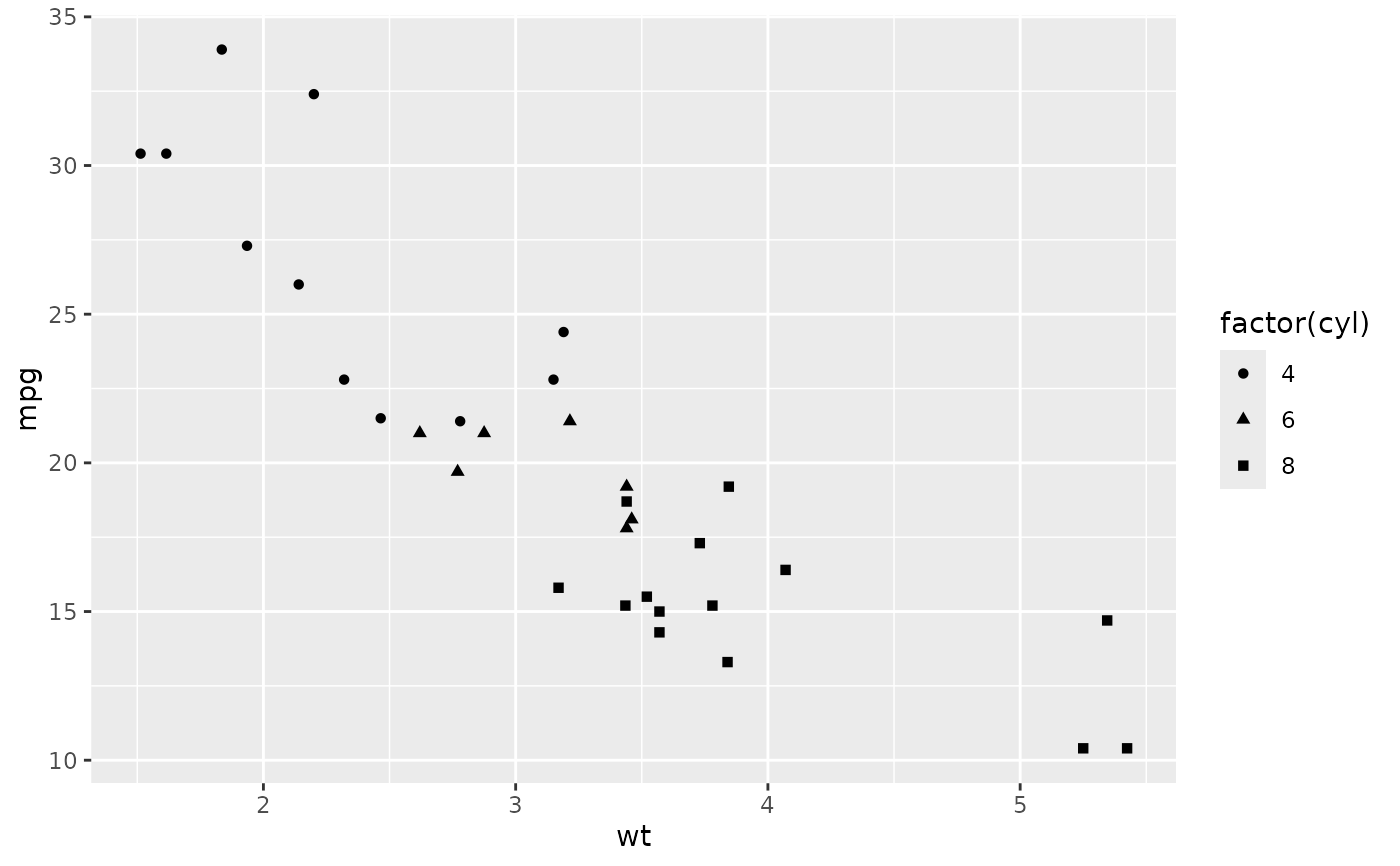 # A "bubblechart":
p + geom_point(aes(size = qsec))
# A "bubblechart":
p + geom_point(aes(size = qsec))
 # Set aesthetics to fixed value
ggplot(mtcars, aes(wt, mpg)) + geom_point(colour = "red", size = 3)
# Set aesthetics to fixed value
ggplot(mtcars, aes(wt, mpg)) + geom_point(colour = "red", size = 3)
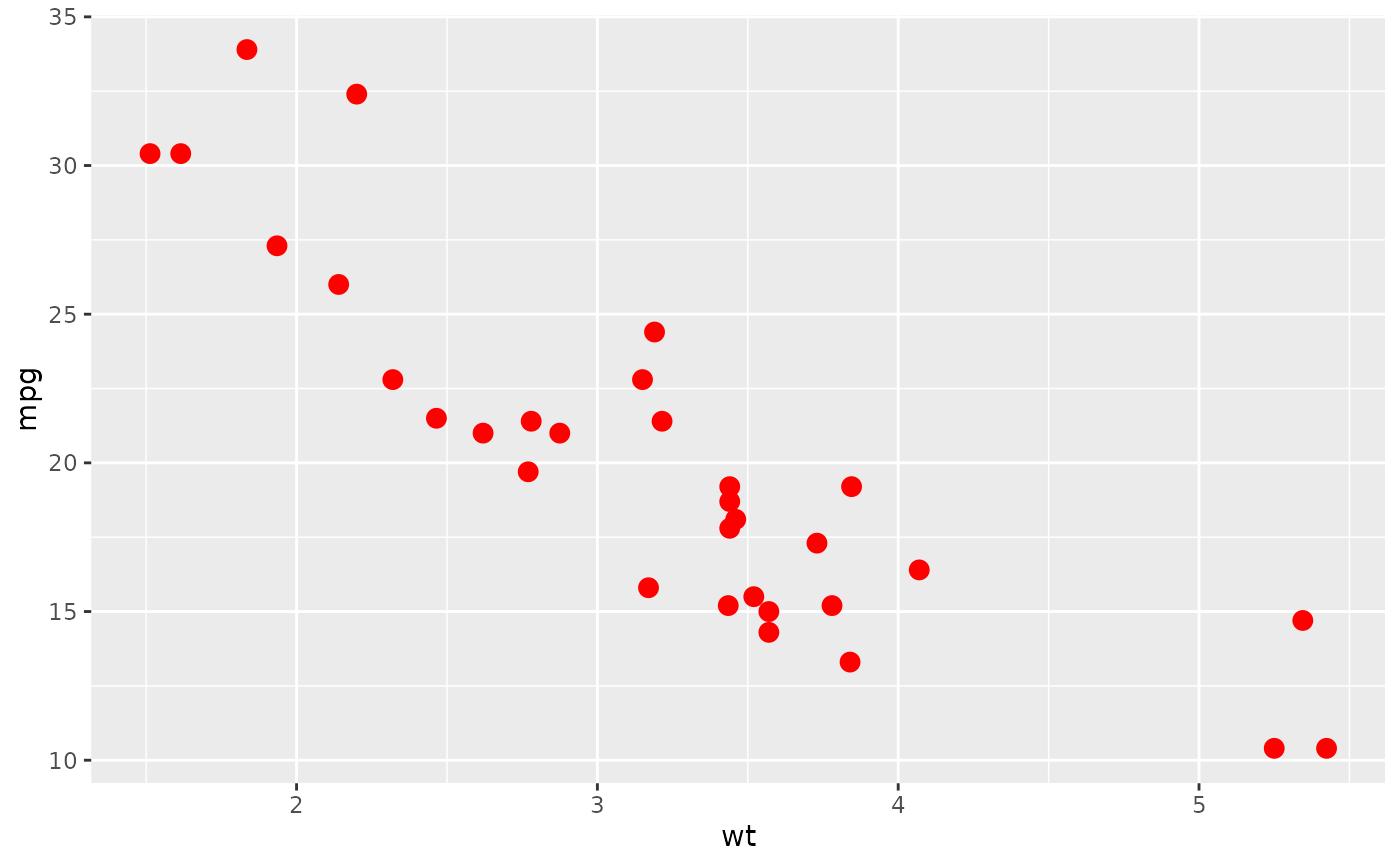 # \donttest{
# Varying alpha is useful for large datasets
d <- ggplot(diamonds, aes(carat, price))
d + geom_point(alpha = 1/10)
# \donttest{
# Varying alpha is useful for large datasets
d <- ggplot(diamonds, aes(carat, price))
d + geom_point(alpha = 1/10)
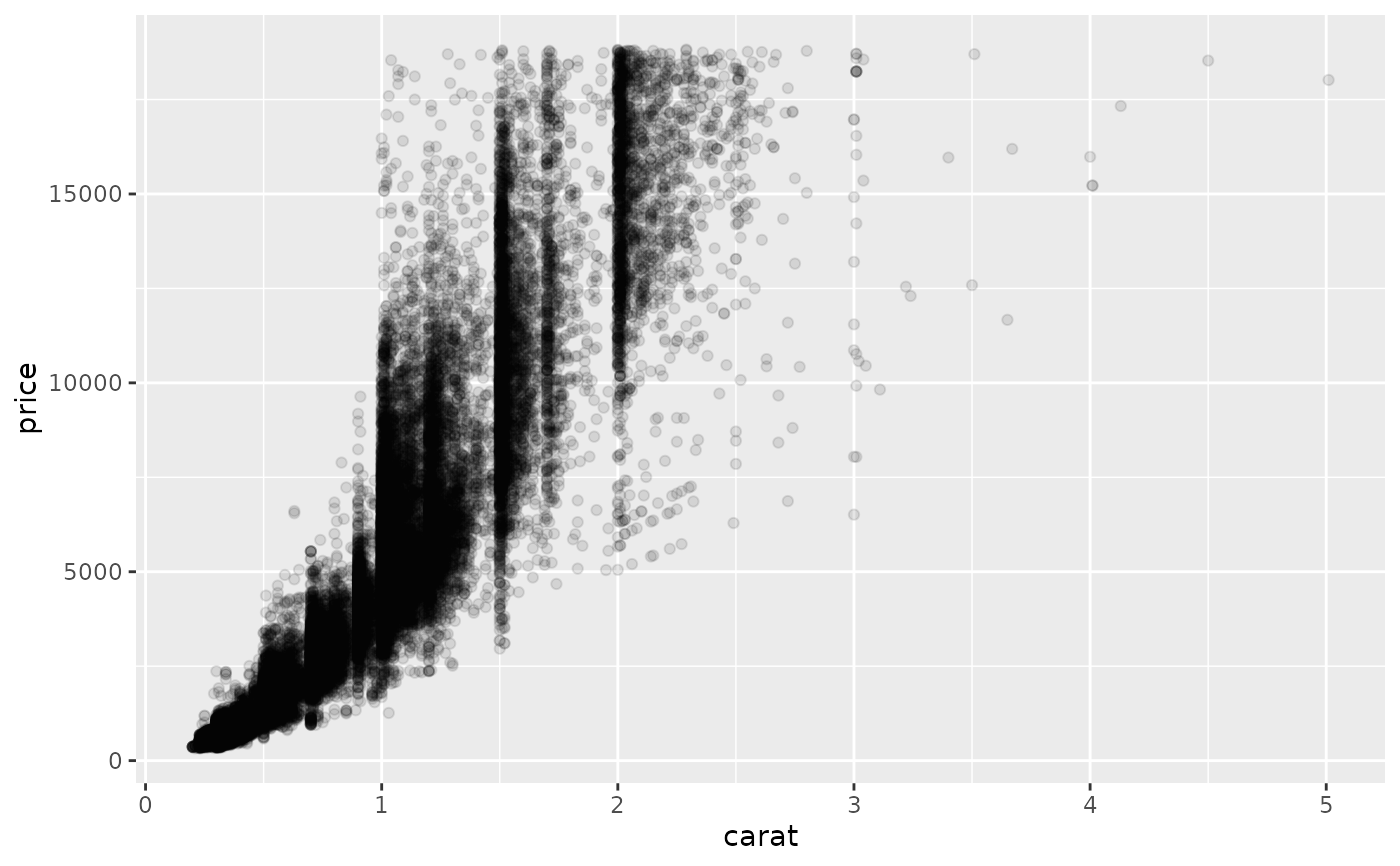 d + geom_point(alpha = 1/20)
d + geom_point(alpha = 1/20)
 d + geom_point(alpha = 1/100)
d + geom_point(alpha = 1/100)
 # }
# For shapes that have a border (like 21), you can colour the inside and
# outside separately. Use the stroke aesthetic to modify the width of the
# border
ggplot(mtcars, aes(wt, mpg)) +
geom_point(shape = 21, colour = "black", fill = "white", size = 5, stroke = 5)
# }
# For shapes that have a border (like 21), you can colour the inside and
# outside separately. Use the stroke aesthetic to modify the width of the
# border
ggplot(mtcars, aes(wt, mpg)) +
geom_point(shape = 21, colour = "black", fill = "white", size = 5, stroke = 5)
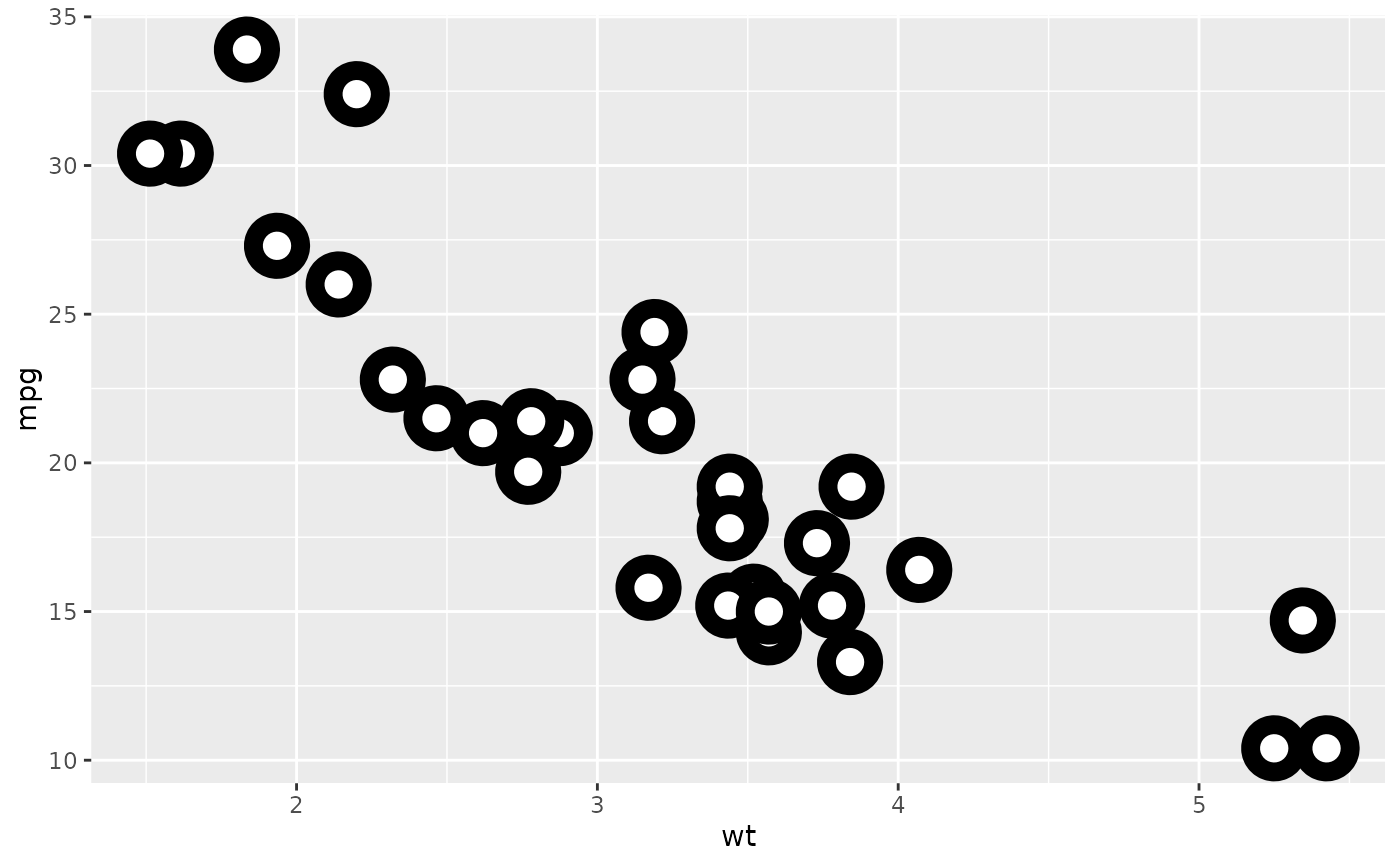 # The default shape in legends is not filled, but you can override the shape
# in the guide to reflect the fill in the legend
ggplot(mtcars, aes(wt, mpg, fill = factor(carb), shape = factor(cyl))) +
geom_point(size = 5, stroke = 1) +
scale_shape_manual(values = 21:25) +
scale_fill_ordinal(guide = guide_legend(override.aes = list(shape = 21)))
# The default shape in legends is not filled, but you can override the shape
# in the guide to reflect the fill in the legend
ggplot(mtcars, aes(wt, mpg, fill = factor(carb), shape = factor(cyl))) +
geom_point(size = 5, stroke = 1) +
scale_shape_manual(values = 21:25) +
scale_fill_ordinal(guide = guide_legend(override.aes = list(shape = 21)))
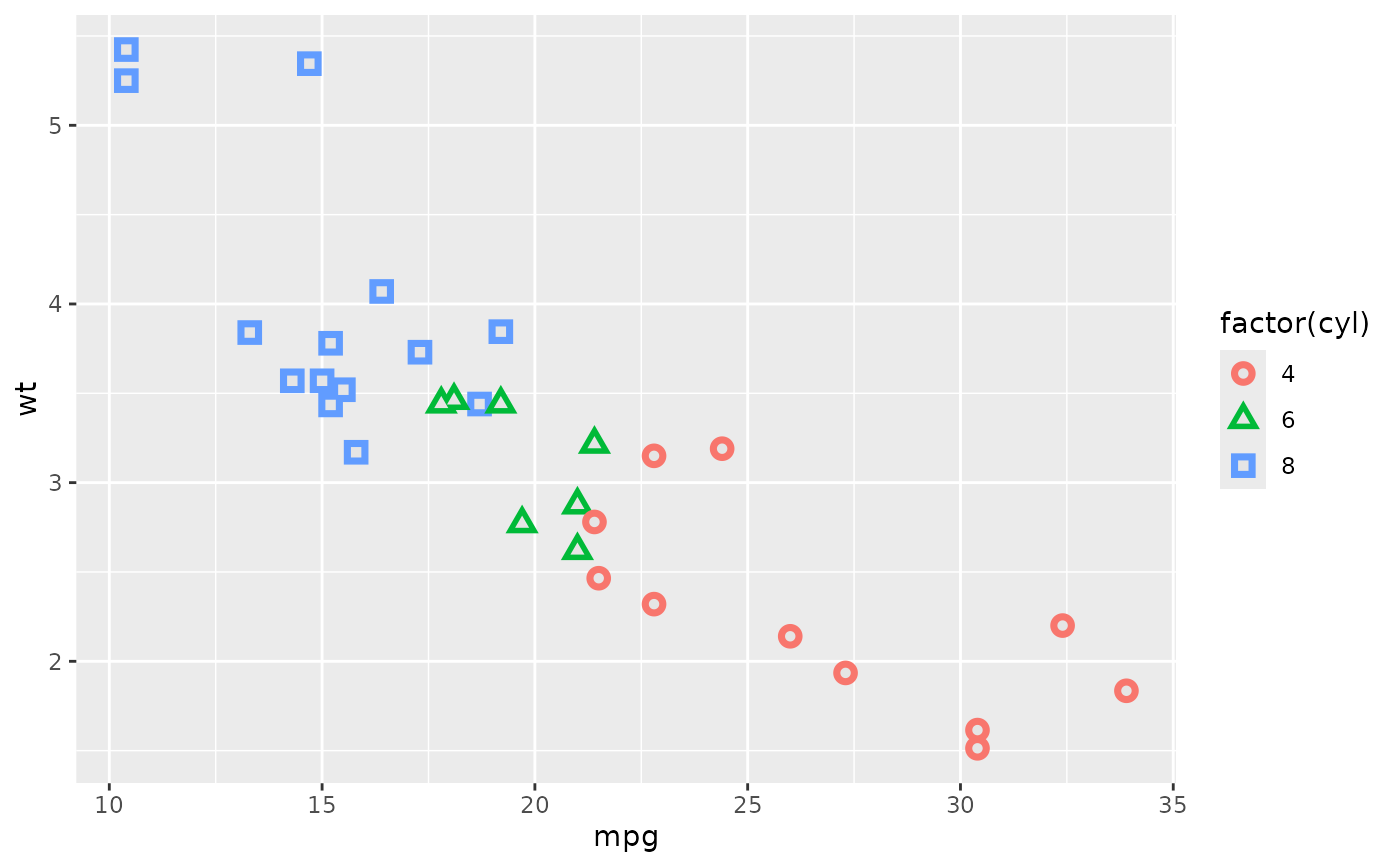 # \donttest{
# You can create interesting shapes by layering multiple points of
# different sizes
p <- ggplot(mtcars, aes(mpg, wt, shape = factor(cyl)))
p +
geom_point(aes(colour = factor(cyl)), size = 4) +
geom_point(colour = "grey90", size = 1.5)
# \donttest{
# You can create interesting shapes by layering multiple points of
# different sizes
p <- ggplot(mtcars, aes(mpg, wt, shape = factor(cyl)))
p +
geom_point(aes(colour = factor(cyl)), size = 4) +
geom_point(colour = "grey90", size = 1.5)
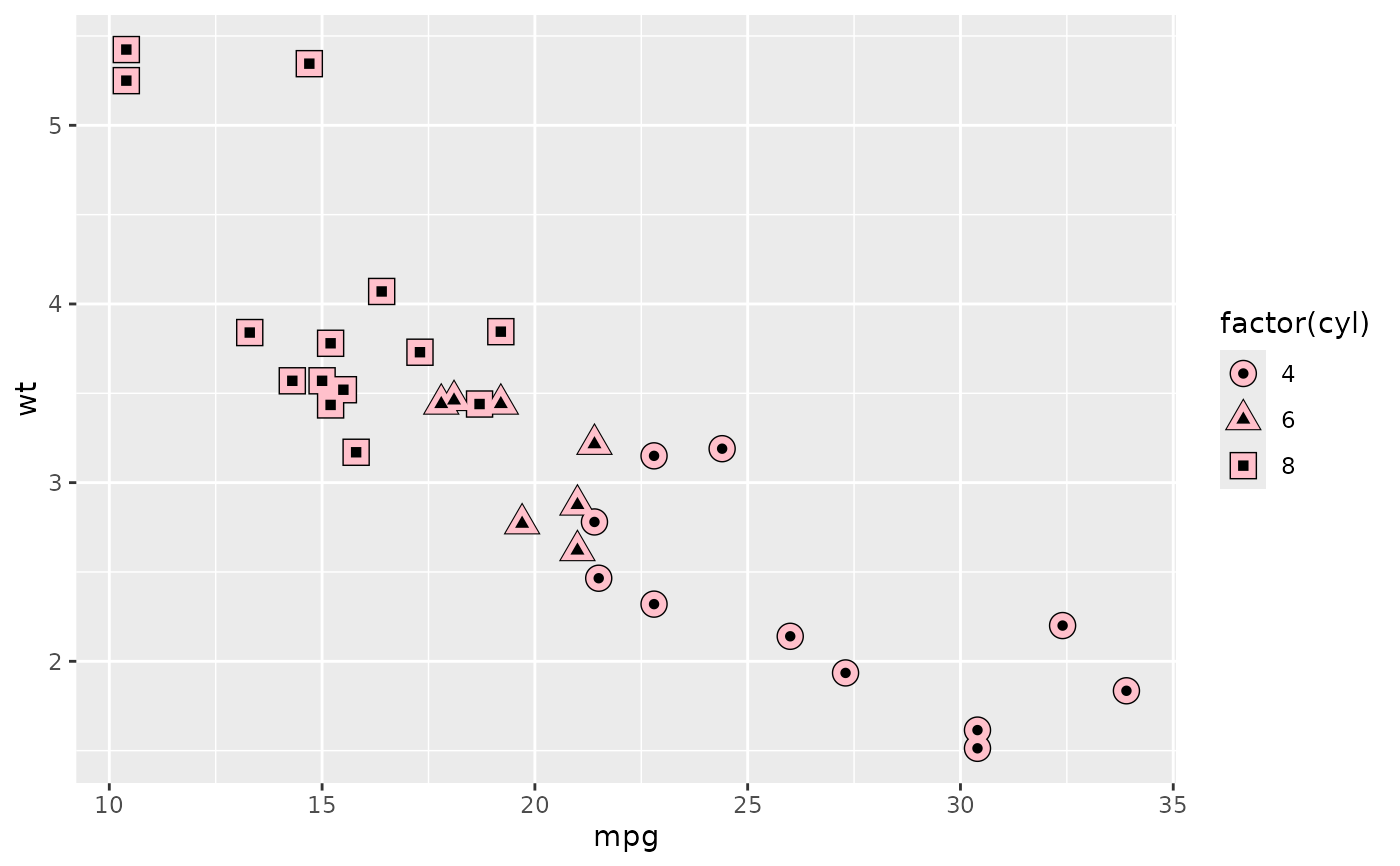 p +
geom_point(colour = "black", size = 4.5) +
geom_point(colour = "pink", size = 4) +
geom_point(aes(shape = factor(cyl)))
p +
geom_point(colour = "black", size = 4.5) +
geom_point(colour = "pink", size = 4) +
geom_point(aes(shape = factor(cyl)))
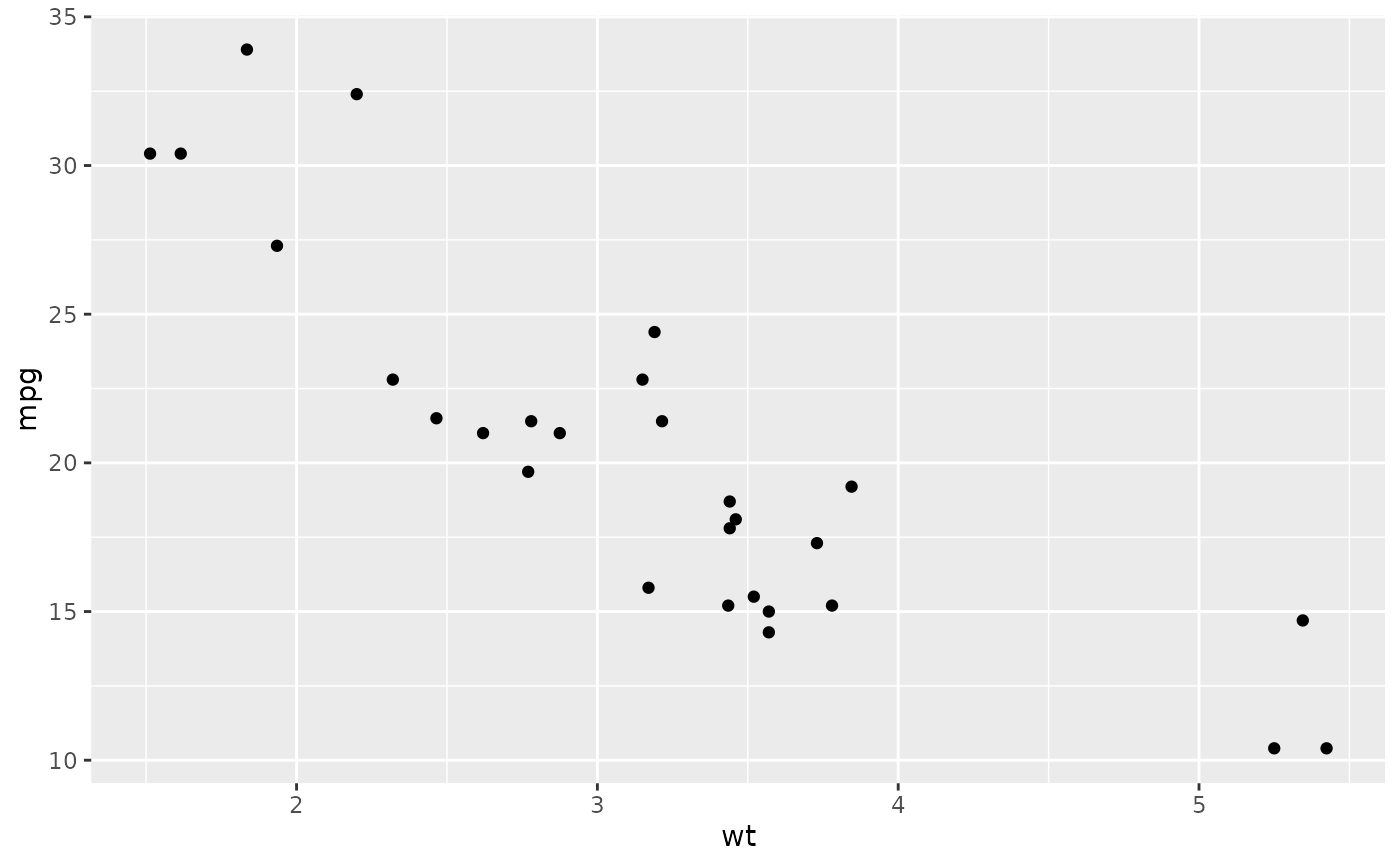 # geom_point warns when missing values have been dropped from the data set
# and not plotted, you can turn this off by setting na.rm = TRUE
set.seed(1)
mtcars2 <- transform(mtcars, mpg = ifelse(runif(32) < 0.2, NA, mpg))
ggplot(mtcars2, aes(wt, mpg)) +
geom_point()
#> Warning: Removed 4 rows containing missing values or values outside the scale
#> range (`geom_point()`).
# geom_point warns when missing values have been dropped from the data set
# and not plotted, you can turn this off by setting na.rm = TRUE
set.seed(1)
mtcars2 <- transform(mtcars, mpg = ifelse(runif(32) < 0.2, NA, mpg))
ggplot(mtcars2, aes(wt, mpg)) +
geom_point()
#> Warning: Removed 4 rows containing missing values or values outside the scale
#> range (`geom_point()`).
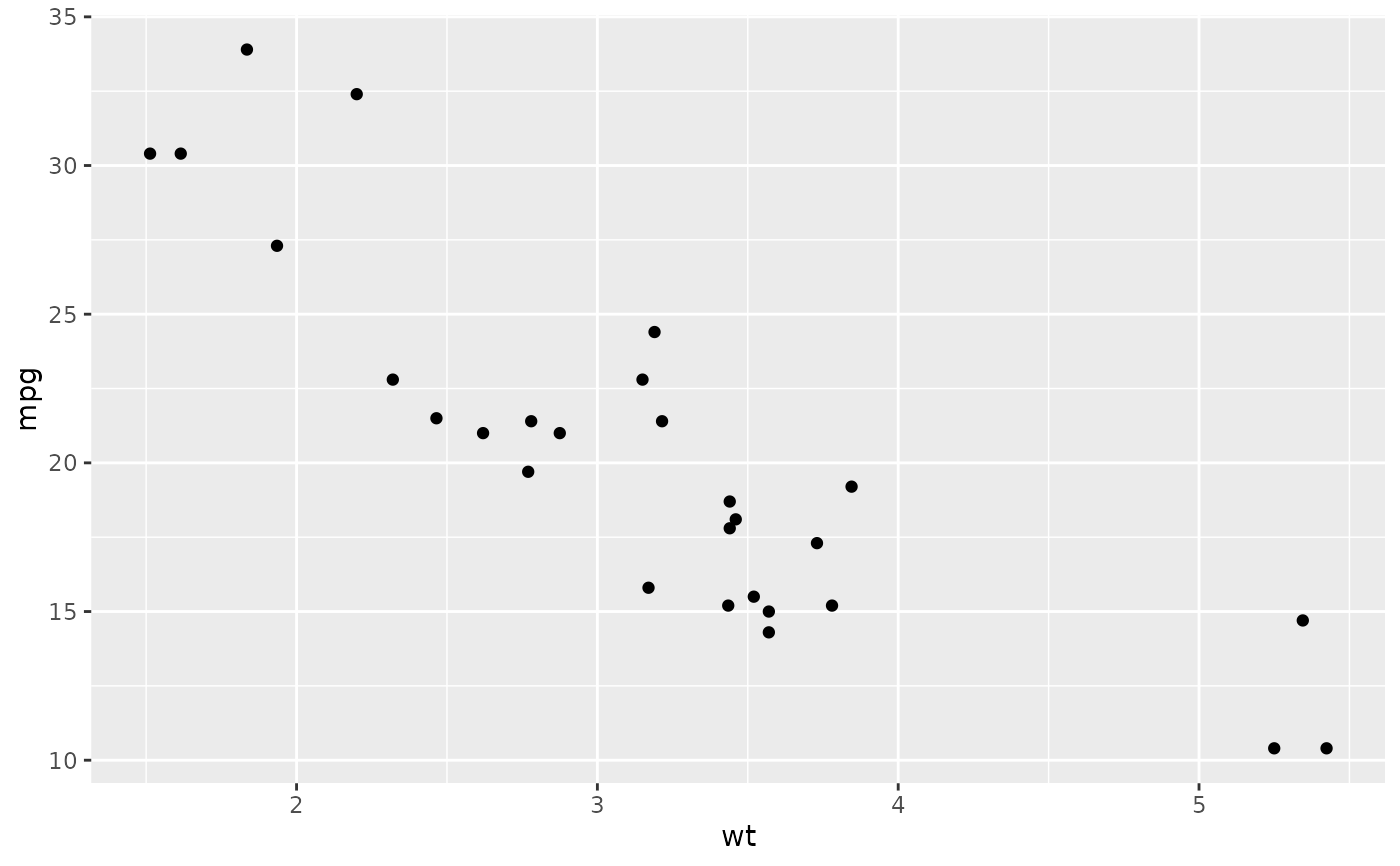 ggplot(mtcars2, aes(wt, mpg)) +
geom_point(na.rm = TRUE)
ggplot(mtcars2, aes(wt, mpg)) +
geom_point(na.rm = TRUE)
 # }
# }
